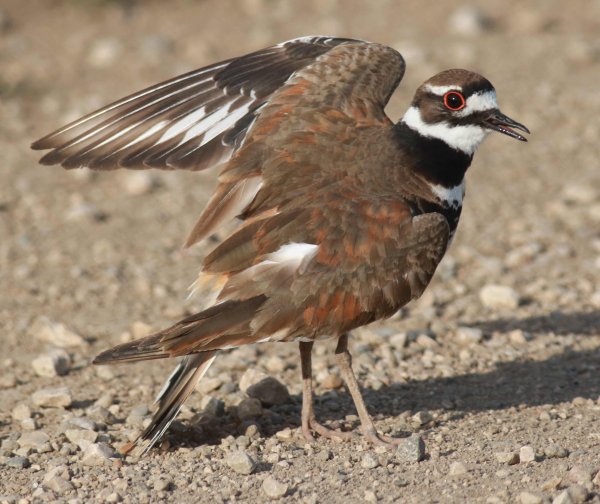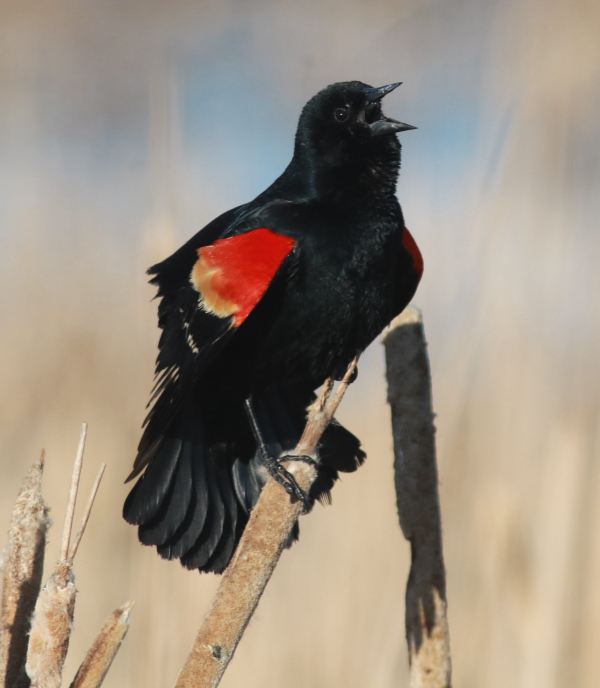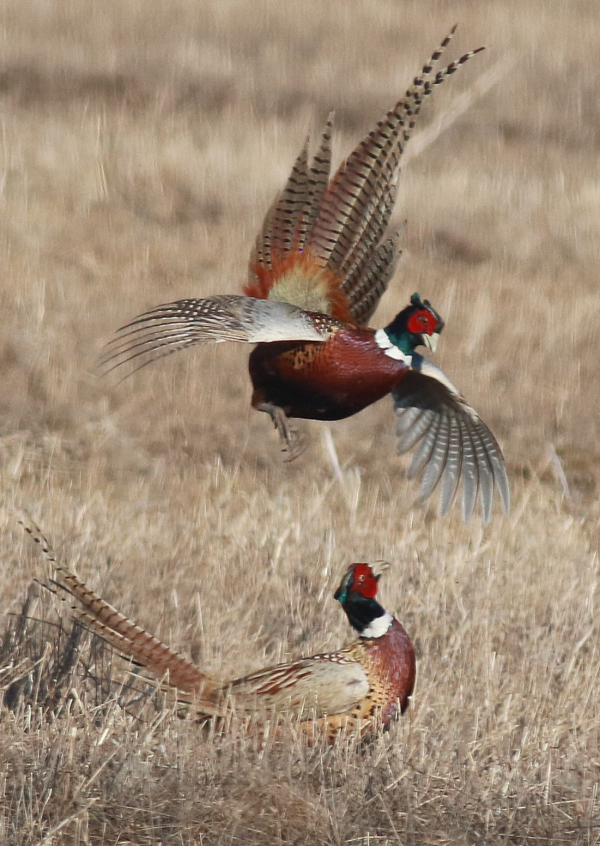Sometimes we get caught up with photographing the most interesting, most colorful, or rarer birds, only to overlook some of the more common birds we see daily, or at least regularly in season. There are still times when I need to remind myself to emphasize the most common birds – the robins, wrens, and blackbirds; the gulls, killdeers, Savanah Sparrows, and Horned Larks to mention a few. Plus, there is always the chance to photograph a new behavior or interaction, or a bird landing or taking off.

Although a Yellow-headed Blackbird may not be common in your area, they are abundant Paul’s region of Dakota, where they provide great opportunities to photograph males displaying on territory.
|
At times I’ve found that I have an abundance of photos of eagles, egrets, and pheasants, but few of grackles, swallows, and finches. So when bird photo ops are hard to come by, or when the season is prime, spend some time emphasizing photographing common birds in your neighborhood, or that you find in the field. Not only will you add new photos for your files, but you can get some important practice time with your camera using birds and field conditions to sharpen your photo skills and attention to technical details.
Beyond Instruction
I provide a lot of information that I have gleaned over years of practice, study, and experience in these weekly Bird Photography articles with the hope that you can avoid some of the mistakes you might make without focused instruction. A simple example of information I emphasize almost weekly is to be aware of the direction of the sunlight and that it’s best to position yourself between the sun and the bird you are photographing. When I was a beginner, I wish someone had given me the single insight to photograph wildlife with the sun at my back. It took a lot of “wasted” efforts to come to that insight after a year or so of hit and miss photo opportunities and “experimenting.”
But sometimes it’s important for you to see for yourself how different lighting conditions at different time of the day affect your photos, and how photographing a bird from different angles and directions affects your photos. Use common birds in your area to practice, and experiment a little, with different lighting conditions. Take some photos that you know won’t be good photos, but will emphasize the need to position yourself correctly.

Note the rich variations of yellow color, as well as highlights in the black plumage that are indicative of the excellent lighting conditions.
|
For instance, try taking photos from different directions when you have a fairly static subject; from east, west, north, and south to show yourself the effects of the light direction on the quality of the photos overall, as well as the effect of backlighting and side shadows, keeping in mind that shadows always show up darker on photos than we perceive them through our eyes.
You can also hone in on some more subtle interests; for example, notice how some feathers or areas of plumage change shades of color as the bird turns its head and catches a different angle of light. Also, make it a regular practice to focus on the eye when photographing any bird.
You may also appreciate taking some photos of common birds at different times of the day – when the sun is directly overhead during midday, during early and late morning sessions, plus late afternoon and evening. Watch your shadow and how the angle of the sun changes the lenth of it, and practice watching for the changing intensity of the light. Also try photographing under different weather conditions – especially during cloud cover versus prime light and overhead light. These experiments will serve you well over time as you judge various photo settings and conditions, and they will emphasize the need to plan your photo periods wisely for the best chance at getting the best photos.
Why the emphasis on testing the effects of light for yourself? Photography relies on light and light conditions can make the difference between great, good, and not-so-good photos. The more practice you have, the more experience you get, and you will see that indeed, I’m providing some useful suggestions and shortcuts that will serve you well and save you time and missed opportunities – with common and rarer birds.
RTP Photographing Common Birds

Killdeer are especially fun to photograph as they display, as long as you aren’t impacting them near a nest or hatchlings. This Killdeer literally blocked the trail, providing a few moments to take action photos.
|
A lesson about photographing common birds that I like to share came from spending time in the field with Roger Tory Peterson. He became especially interested, or re-interested, in photographing birds when he was in his 80s. The first time we photographed together, we spent loads of time photographing new broods of downy Canada Geese at Forsythe Refuge on the New Jersey coast. Given, it was perfect timing to photograph the abundant broods of newly hatched goslings, and they were such wonderful subjects – but they were common birds – and I must admit that I was more excited about the Gull-billed Terns and Peregrine Falcons. But hey, I was hangin’ with Roger!
When I related my experience to my pro photographer friend Brian Small, he shared a similar experience with Roger. When Brian and his father, UCLA Professor Arnold Small, took Roger on a field trip in central North Dakota, Roger was keyed in on photographing another common species, Red-winged Blackbirds. For me, these insights were a lesson that even for Roger Tory Peterson, who had traveled the world and described birds, birding expeditions, and birding locations filled with penguins and puffins, Ostriches and Emus, and thousands of other species, common birds were still attractive photo subjects.
Roger was good at teaching things through his actions, although he was great at telling insightful stories too. One of his favorite stories revealed that a common bird – a Northern Flicker – was his favorite, or at least one of his favs. Certainly, common birds can provide a welcome relief from otherwise uneventful time in the field, or when in search of photo subjects in your yard or neighborhood.
Common Birds Lead to a Lifetime Encounter

Red-winged Blackbirds can be more of a challenge when trying to get a photo with the red feathers showing prominently during a territorial song display. When you have a bird on location for some time, it’s always worthwhile trying some technical options by changing the depth of field and shutter speed.
|
Last spring I was in a location with great potential and perfect light, but the exciting birds I was hoping to photograph were no shows, or I needed to be more patient and remain in position for things to happen eventually. In the meantime, the abundant Yellow-headed Blackbirds and Red-winged Blackbirds were especially active on their territories among a vast cattail stand, so I turned my attention to these common birds – and maybe, in addition to getting some nice display photos, another photo option would present itself.
I wish I had the perfect light during the ensuing hour all the time, and I worked through many photo settings the blackbirds provided as they sang, displayed, and interacted through the area. I kept aware of the backgrounds and how the mostly black plumage of the Red-wings required a little extra attention to make sure the light highlighted some feathers, and one eye. The Yellow-heads were unparalleled in the photo ops they provided, and I must have documented every twist and turn possible during their territorial displays in the perfect light.
And I was eventually rewarded for fighting off my interests in checking out other nearby locations for other birds. As I was photographing a Red-winged Blackbird singing, I heard a muffled sound that I immediately recognized as the wingbeats of a pheasant – and it sounded as though pheasants were fighting just 30 feet away. I cautiously began repositioning, but the pheasants immediately reacted by moving from the cover of some small willows into the open – what luck! And they were so intent on one another that they did not flee, but resumed their fight in earnest, spreading their wings and tail, jumping and flapping their wings, repositioning and resuming the flay – Wow!

Patience photographing common birds – Red-winged and Yellow-headed Blackbirds – led to an extremely rare opportunity to photograph phighting pheasants.
|
This was the answer to my waiting on site and passing time with the blackbirds – seven minutes of pheasant fighting as I’ve never before witnessed or photographed. What fun, and what a personal achievement to document the battling Ring-necks; but in hindsight, it was also fun, helpful, and rewarding to take the series of photos of blackbirds too. The blackbird photos were actually better quality images, and they are the best images I have of both of these species displaying. (To review a series of the fighting Ring-necked Pheasant photos, you can click on the Archives button at the top of the webpage, and open the May 6th issue’s Bird Photography article.)
As you are photographing common birds, don’t stop at a single portrait photo. Take your image quest to another level by working on action photos of each species: Behavioral displays, singing, feeding, interacting, flying, and more. The key is that when a rarer bird, or a species you’ve been hoping and wishing to photograph for years suddenly appears, you will have the experience and a natural reaction to make the most out of fleeting moments, or an extended photo opportunity. Then too, some days, a photo is a photo, and a bird is a bird, and together they add up to a whole lotta fun for any photographer. Enjoy photographing the birds of August!
Article and photographs by Paul Konrad
Share your bird photos and birding experiences at editorstbw2@gmail.com